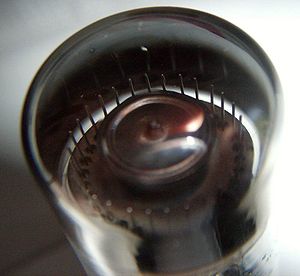
Dekatron
Encyclopedia

Electronics
Electronics is the branch of science, engineering and technology that deals with electrical circuits involving active electrical components such as vacuum tubes, transistors, diodes and integrated circuits, and associated passive interconnection technologies...
, a Dekatron (or Decatron, or generically three-phase gas counting tube or glow-transfer counting tube or cold cathode tube) is a gas-filled decade counting tube. Dekatrons were used in computers, calculators and other counting-related products during the 1950s and 1960s. "Dekatron," now a generic trademark, was the brand name used by the British Ericsson Telephones Limited (ETL), of Beeston, Nottingham
Nottingham
Nottingham is a city and unitary authority in the East Midlands of England. It is located in the ceremonial county of Nottinghamshire and represents one of eight members of the English Core Cities Group...
(not the Swedish TelefonAB L. M. Ericsson
Ericsson
Ericsson , one of Sweden's largest companies, is a provider of telecommunication and data communication systems, and related services, covering a range of technologies, including especially mobile networks...
, of Stockholm).

Hydrogen
Hydrogen is the chemical element with atomic number 1. It is represented by the symbol H. With an average atomic weight of , hydrogen is the lightest and most abundant chemical element, constituting roughly 75% of the Universe's chemical elemental mass. Stars in the main sequence are mainly...
-filled fast dekatrons. Dekatrons filled with inert gas
Inert gas
An inert gas is a non-reactive gas used during chemical synthesis, chemical analysis, or preservation of reactive materials. Inert gases are selected for specific settings for which they are functionally inert since the cost of the gas and the cost of purifying the gas are usually a consideration...
are inherently more stable and have a longer life, but their counting frequency is limited to 10 kHz (1–2 kHz is more common).
Internal designs vary by the model and manufacturer, but generally a dekatron has ten cathode
Cathode
A cathode is an electrode through which electric current flows out of a polarized electrical device. Mnemonic: CCD .Cathode polarity is not always negative...
s and one or two guide electrodes plus a common anode
Anode
An anode is an electrode through which electric current flows into a polarized electrical device. Mnemonic: ACID ....
. The cathodes are arranged in a circle with a guide electrode (or two) between each cathode. When the guide electrode(s) is pulsed properly, the neon gas will activate near the guide pins then "jump" to the next cathode. Pulsing the guide electrodes (negative going pulses) repeatedly will cause the neon dot to move from cathode to cathode.

Some dekatrons have only one cathode wired to its own socket pin and the remaining nine cathodes tied together to another pin. Other dekatrons have all ten cathodes wired to their own individual pins. The latter allows for monitoring the "status" of each cathode or to divide-by-n with the proper reset circuitry. This kind of versatility made such dekatrons useful for numerical division in early calculators.
Dekatrons come in various physical sizes, ranging from smaller than a 7-pin miniature vacuum tube
Vacuum tube
In electronics, a vacuum tube, electron tube , or thermionic valve , reduced to simply "tube" or "valve" in everyday parlance, is a device that relies on the flow of electric current through a vacuum...
to as large as an octal base tube. While most dekatrons are decimal counters, models were also made to count in base-5 and base-12 for specific applications.
The dekatron fell out of practical use when transistor
Transistor
A transistor is a semiconductor device used to amplify and switch electronic signals and power. It is composed of a semiconductor material with at least three terminals for connection to an external circuit. A voltage or current applied to one pair of the transistor's terminals changes the current...
-based counters became reliable and affordable. Today, dekatrons are used by electronic hobbyists in simple "spinners" that run off the mains frequency (50Hz or 60Hz) or as a numeric indicator for homemade clocks.
See also
- Sumlock ANITA calculatorSumlock ANITA calculatorThe ANITA Mark VII and ANITA Mark VIII calculators were launched simultaneously in late 1961 as the world's first all-electronic desktop calculators. Designed and built by the Bell Punch Co...
— The world's first desktop electronic calculators, which used Dekatrons. - WITCHWITCH (computer)The Harwell computer, later known as the Wolverhampton Instrument for Teaching Computing from Harwell , or the Harwell Dekatron Computer, was an early British relay-based computer...
— Early British relay based computer that used Dekatrons.

